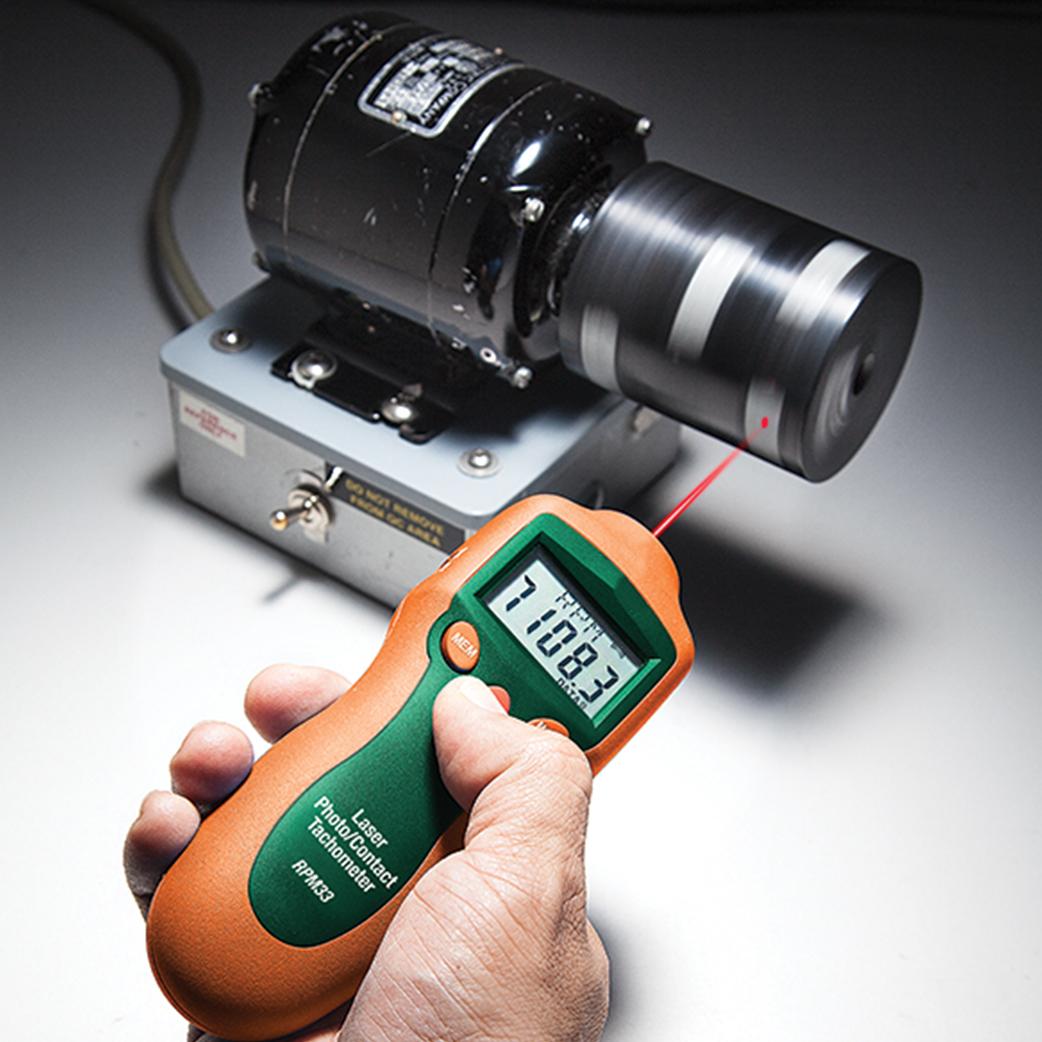如何使用光电转速表
要使用光电转速表,首先要在要测量的旋转表面上创建一个反射标记。您还必须确保旋转曲面的其余部分相对而言不反光。一个简单的方法是在黑色或暗淡的金属轴上用油漆标记创建一个白点。然后,将光电转速表发出的光束对准旋转轴上的标记。每次反射点通过光电转速表的光束时,一些光都会被反射回光电转速表,并在那里被光传感器接收。通过计算光传感器在给定时间内触发的次数,可以确定被测机械的转速。
例如,假设我们有一个电机以每分钟1200转的速度旋转。我们将光电转速表的光束对准我们在电机轴上标记的白点。让我们假设光电转速表计算它在一秒钟的单位时间内看到的脉冲数量来进行测量。在一秒钟内,白点将通过光束20次,在光束经过时触发我们的光传感器。然后,光电转速表中的微控制器进行一些简单的数学运算——一秒钟内20个脉冲,乘以60秒——我们在显示屏上得到每分钟1200转的转速。
很容易想象,如果我们的轴旋转得慢得多,大约每分钟10转,我们的光电转速表每六秒钟只会看到一个脉冲。如果我们把转速提高到12转/分,它仍然是每五秒只有一个脉冲。我们的转速表在测量如此低的转速时会受到影响,它需要很长时间才能注意到任何变化。在这种情况下,我们能做些什么吗?
为什么是的,有!我们可以在旋转轴上放置更多的反射点。让我们在旋转电机轴上画十个点。现在,在10转/分的转速下,我们每0.6秒就会得到一个光脉冲,在12转/分,每0.5秒就会得到。我们的转速表现在能够更快地响应低速范围内的速度变化——我们只需要记住将显示速度除以10,就可以考虑到我们的额外标记。
反光性更强的标记效果更好。
还有其他技巧可以用来提高性能。许多光电转速表或激光转速表的盒子里都有反光胶带。这是一种特殊的胶带,反光胶带上的微粒可以让胶带以任何角度反射光线。在旋转机器上使用这种反光胶带代替白色油漆,可以让我们用光电转速表在与标记垂直的角度之外进行测量。我自己用这个来测量我汽车的发动机转速。不可能将转速表直接指向曲轴,但有了反光带,我可以从上方以一个奇怪的角度将激光指向曲轴皮带轮,仍然可以获得良好的读数。

HOW TO USE A PHOTO TACHOMETER
To use the photo tachometer, you start by creating a reflective mark on the rotating surface you wish to measure. You must also ensure the rest of the rotating surface is comparatively non-reflective. An easy way to do this would be to create a white spot with a paint marker on an otherwise black or dull-metal shaft. Then, aim the beam of light from the photo-tachometer at the mark on the spinning shaft. Each time the reflective spot passes the beam of the photo-tachometer, some light is reflected back towards the device, where it is picked up by a light sensor. By counting the number of times the light sensor is triggered in a given time, it’s possible to determine the rotational speed of the machinery under test.
For example, let’s say we have a motor spinning at 1200 revolutions per minute. We aim the photo-tachometer’s beam at the white spot we’ve marked on the motor’s shaft. Let’s assume the photo-tachometer counts the number of pulses it sees in a unit time of one second to make its measurements. In one second, the white spot will pass the beam twenty times, triggering our light sensor as it goes by. The microcontroller in the photo-tachometer then does some simple maths – twenty pulses in one second, multiplied by 60 seconds – and we get a rotational speed of 1200 revolutions per minute on the display.
It is easy to imagine that if our shaft is rotating much more slowly, on the order of 10 RPM, our photo-tachometer will only see one pulse every six seconds. If we up this to 12 RPM, it’s still only one pulse every five seconds. Our tach is going to suffer trying to measure such low rotational speeds and it’s going to take a long time for it to notice any changes. Is there anything we can do to help in this situation?
Why yes, there is! We can place additional reflective spots on our rotating shaft. Let’s put ten spots on our rotating motor shaft. Now at 10 RPM, we’re getting a pulse of light every 0.6 seconds, and at 12 RPM, every 0.5 seconds. Our tach is now able to much more quickly respond to changes in speed at the low range – and we just need to remember to divide the display speed by ten to account for our additional markers.
A more reflective marker works better.
There are other tricks you can use to improve performance, too. Many photo-tachs come with a supply of retro-reflective tape in the box. This is a special tape filled with lots of microscopic glass spheres that allow the tape to reflect light at any angle. Using this instead of white paint on a rotating machine allows us to measure with the photo-tachometer at an angle other than perpendicular to the marking. I used this myself to make a measurement of my car’s engine speed. It was impossible to point the tachometer straight at the crankshaft – but with the retro-reflective tape, I was able to point the laser at the crank pulley from above at an odd angle and still get a good reading.









 添加微信咨询!
添加微信咨询!